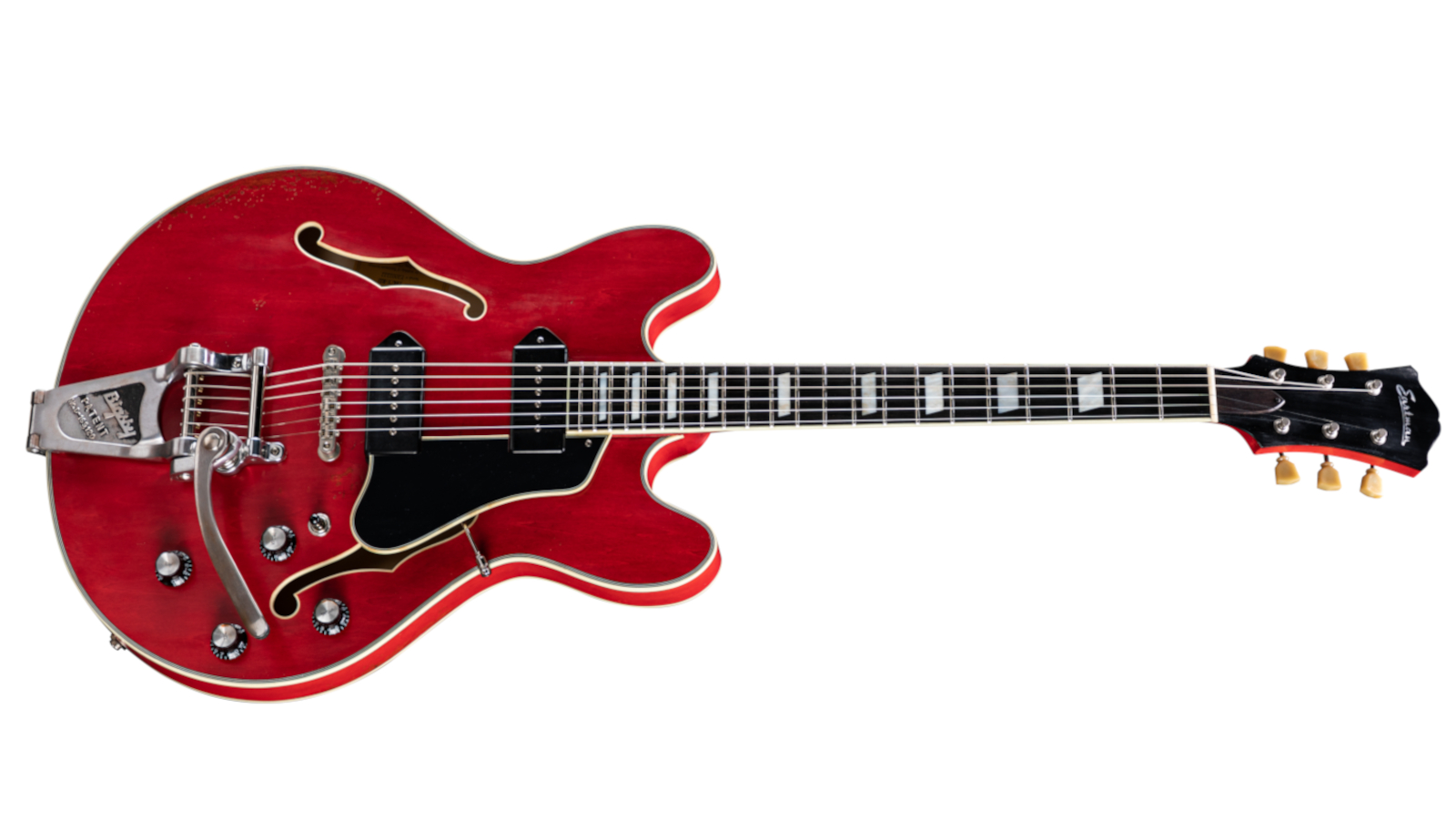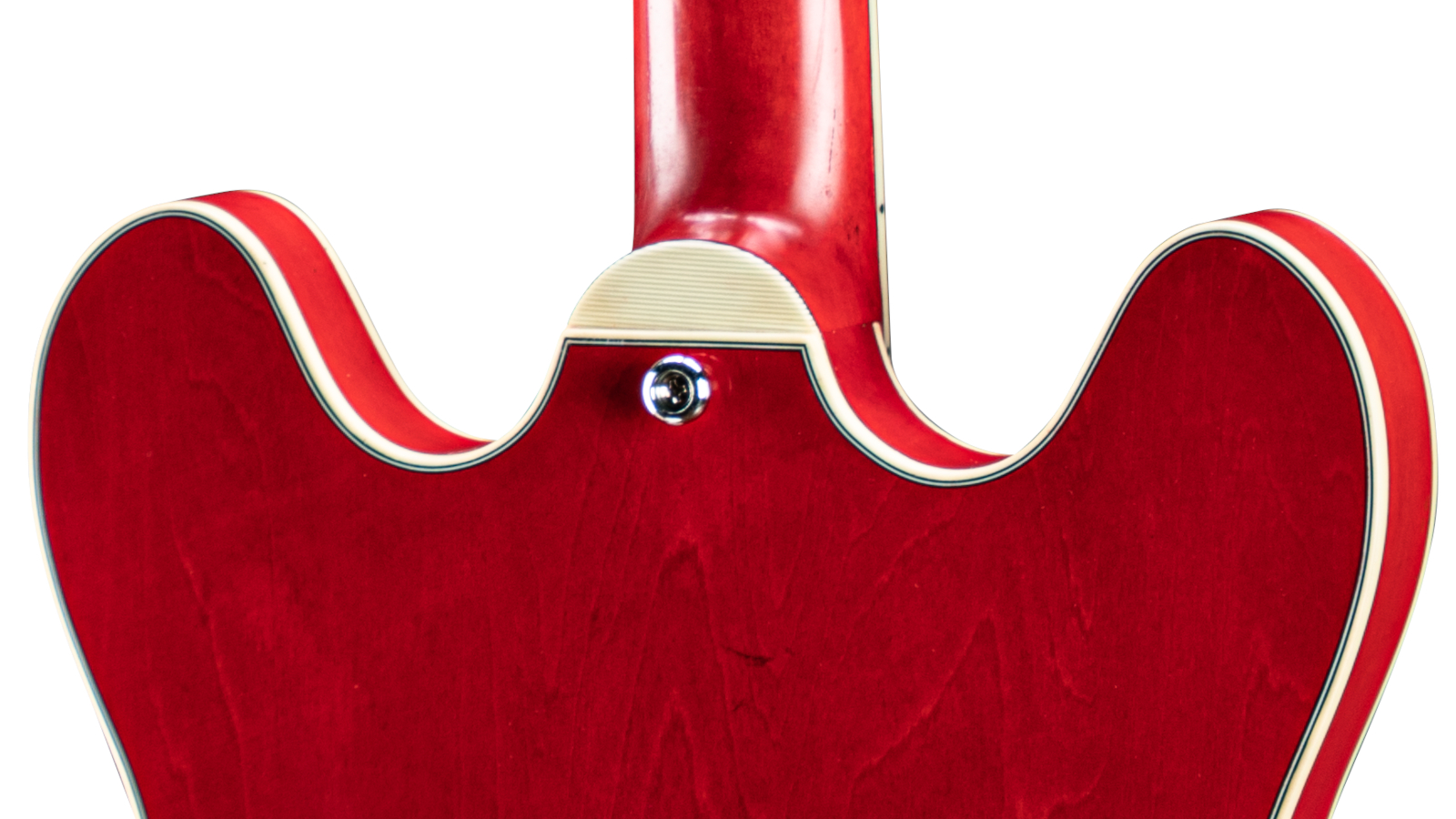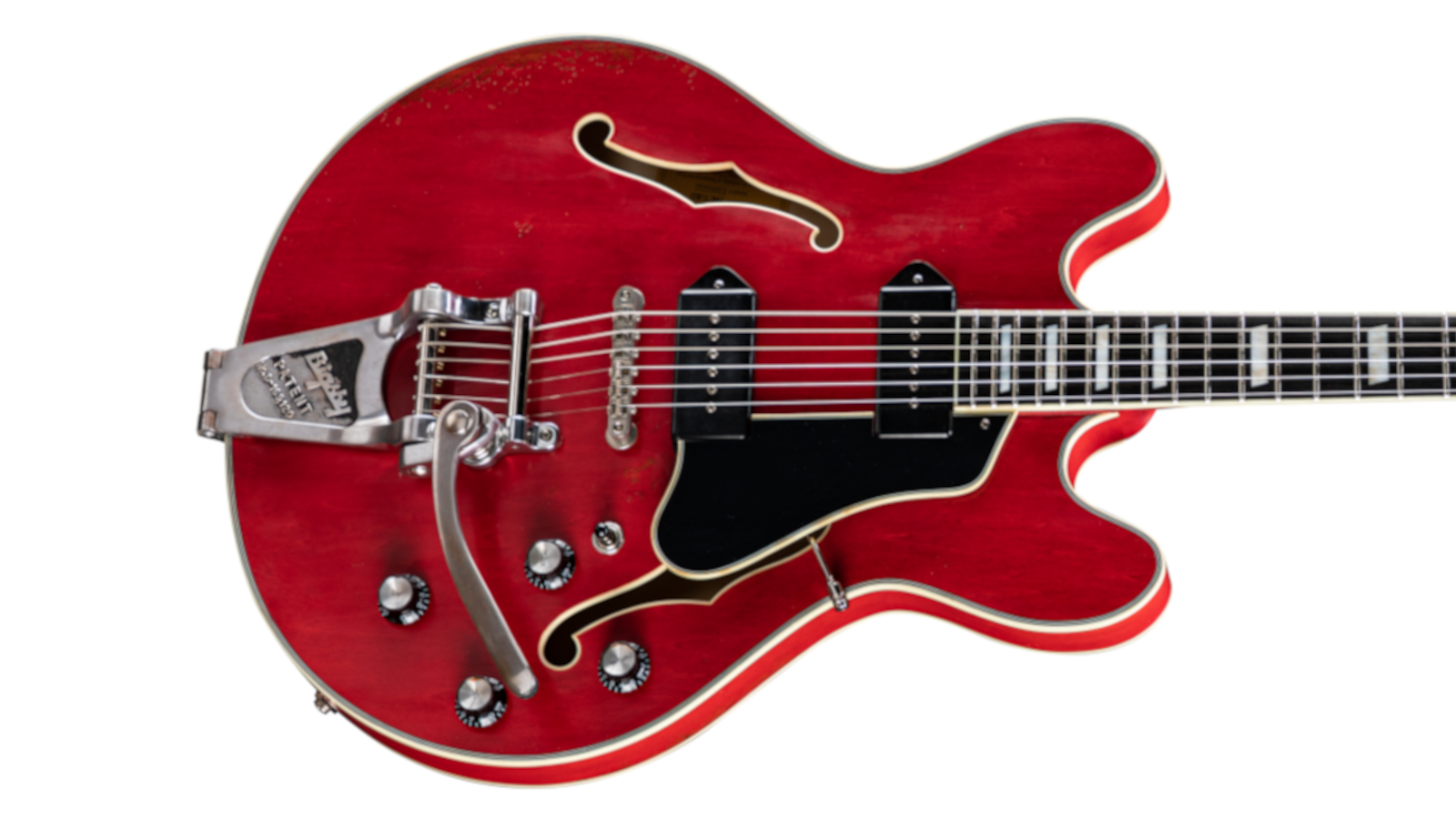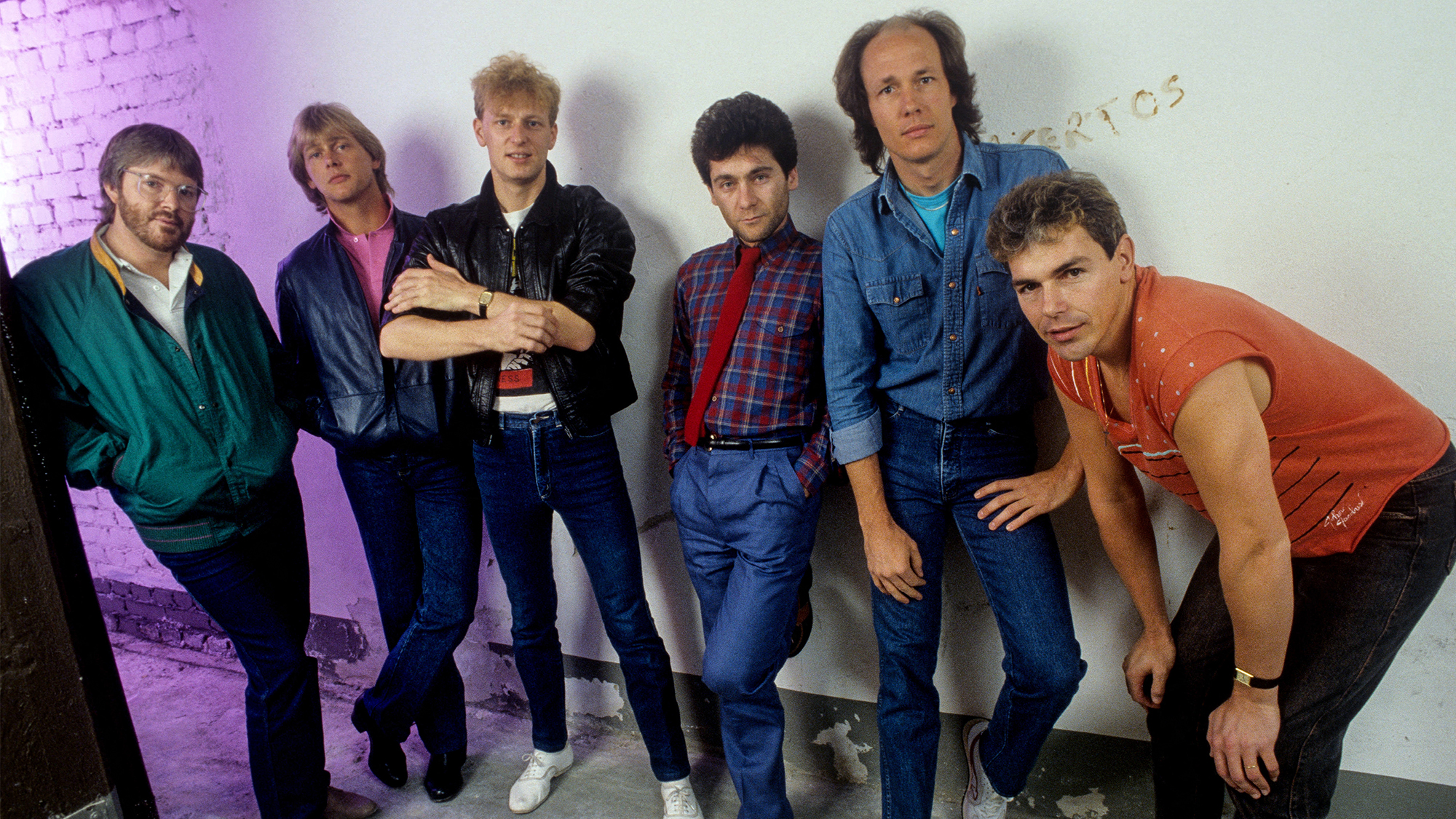GuitarPlayer Verdict
This is a well-conceived, versatile and impressively well-made guitar that delivers a plethora of tones – from throaty snarl to crisp, clear cleans – courtesy of its custom Lollar P-90s
Pros
- +
A clever reimagining of the thinline hollowbody electric
- +
Very well made, excellent playability and surprisingly versatile tones
Cons
- -
Playing position might take slight readjustment for some
You can trust Guitar Player.
Boasting a reputation that grows year upon year, the Eastman String Company has long defied any “budget-brand” preconceptions normally heaped upon Chinese-made guitars, delivering instruments that punch well above their weight for build quality, tone and playability.
Tested through a Deluxe Reverb and a Friedman Mini Dirty Shirley combo (with JHS Bonsai and Tsakalis Six overdrives for dirt), the T64/v displays how this maker eschews the copy-and-clone approach, taking inspiration from classic forms while thoughtfully seeking to improve the designs in the process.

The T64/v we looked at is primarily a new model by virtue of its color, a stunning cherry red done in the hand-rubbed and characterfully aged Antique Varnish that has become one of Eastman’s signature moves.
The enigmatic model name defines a 1964-style, ES-330-inspired thinline hollowbody, with a genuine Bigsby vibrato tailpiece (a non-vibrato version is also available).
As such, this one has a fully hollow 16-inch-wide body made from Eastman’s own deluxe maple laminate, with a glued-in maple neck and ebony fretboard cut to the traditional 24 ¾–inch scale length.

In addition to the slight variations in materials represented there, and the subtle alteration of the body and headstock profiles, other significant changes have been wrought upon the mid-’60s Gibson formula.
“I came up with this guitar because of my many frustrations with traditional thinline hollowbody electrics,” says Pepijn ’t Hart, Eastman’s international sales and product development manager.
All the latest guitar news, interviews, lessons, reviews, deals and more, direct to your inbox!
“It took me forever to finally get a good one, a 1963, and it had a Bigsby. Suddenly it made sense: The rattling was gone because the string angle behind the bridge was much steeper than with a trapeze tailpiece.”

Another of ’t Hart’s frustrations with the classic design was that switching between bridge and neck pickups generally required a total readjustment of amp settings.
Enter Jason Lollar and a custom set of dog-ear P-90s, plus some adjusted positioning courtesy of Eastman master luthier Otto D’Ambrosio, moving the pickups a little closer together on the body.
“The result is that you can use this guitar in all three pickup positions without revoicing the amp,” ’t Hart says.
“So we solved the problems of creating a fully hollow thinline that was a pleasure to play, and at the same time has that unique sound of a hollow guitar with the growl of P-90s.”

In addition to the red varnish finish that looks luscious right out of the case, upgraded cosmetics are represented by multi-ply top and back binding with ivoroid outer layer, ivoroid fretboard binding, pearl parallelogram block inlays and bound f-holes.
To complement the yesteryear look, the hardware displays a subtle patina, including an artfully distressed Bigsby done by Eastman’s master hardware ager Huang Xiaoping, who worked from detailed photos of the original Bigsby on ’t Hart’s 1963 Casino.
Whether it’s the thin varnish finish or the woods and construction – and probably some combination of all three – the guitar is extremely lively and resonant when played unplugged, with an impressive acoustic volume for its depth.

The neck sports a comfortably rounded carve inspired by late-’50s Gibson profiles and feels great in the hand, even at a hair wider than traditional at 1 ¾-inches across the nut, with playability further aided by 22 very well-dressed medium-jumbo frets.
As with the ES-330 and Casino themselves, it’s easy to look at the T64/v and think “it’s an ES-335 with P-90s,” but there are other notable differences in the design.
In addition to the fully hollow body, the neck joint hits at the 16th fret rather than near the end of the fingerboard, which in turn shifts everything else – pickups, bridge, tailpiece – further into the meat of the lower bout, and likewise shifts your playing position.
This brings the left hand closer to the body, which is likely very comfortable to most players. At the same time, it pushes the right hand and shoulder further out to the right if you want to pick down near the bridge, which could be less comfortable for some.

The T64/v’s resonant and balanced acoustic performance translates to a tasty plugged-in tone, and one that’s surprisingly versatile.
The Lollar P-90s deliver the requisite throaty snarl from each position but are also impressively clear and crisp when you want them to be.
As might be expected, given Grant Green’s early excursions on a not-dissimilar design, putting the neck pickup through a clean amp with the tone rolled down a hair delivers a delicious jazz guitar tone that’s never wooly or boomy.

Flick the switch and step on a pedal, and it all translates to rock and roll with a vengeance.
The T64/v easily pushes an edge-of-breakup tube amp into the crunch zone, yielding good dynamics in the process, and takes well to overdrive pedals too.
Feedback can always be an issue with fully hollow thinlines, and the T64/v will howl if you’re not careful about your proximity to a loud amp, especially with some gain from a pedal or lead channel.
But it’s far less out of control than most such electric guitars we’ve played, and admirably resistant for the most part.
All in all, it’s an inspiring guitar, well-conceived and impressively well made, and earns an Editors’ Pick Award for its achievements.

Specifications:
- NUT: Bone, 1 ¾” wide
- NECK: Maple, Traditional Even “C” profile
- FRETBOARD: Ebony, 24.75” scale, 12” radius
- FRETS: 22 medium-jumbo
- TUNERS: Gotoh Relic Series SD90
- BODY: Thinline hollowbody made from deluxe maple laminate
- BRIDGE: Gotoh Relic Series GE104B Tune-o-Matic with Bigsby B7 vibrato tailpiece
- PICKUPS: Two Lollar dogear P-90s
- CONTROLS: Two volume, two tone, three-way selector switch
- FACTORY STRINGS: D’Addario NYXL .011-.049
- WEIGHT: 6.9 lbs
- BUILT: China
Visit Eastman Guitars for more information.
Dave Hunter is a writer and consulting editor for Guitar Player magazine. His prolific output as author includes Fender 75 Years, The Guitar Amp Handbook, The British Amp Invasion, Ultimate Star Guitars, Guitar Effects Pedals, The Guitar Pickup Handbook, The Fender Telecaster and several other titles. Hunter is a former editor of The Guitar Magazine (UK), and a contributor to Vintage Guitar, Premier Guitar, The Connoisseur and other publications. A contributing essayist to the United States Library of Congress National Recording Preservation Board’s Permanent Archive, he lives in Kittery, ME, with his wife and their two children and fronts the bands A Different Engine and The Stereo Field.


